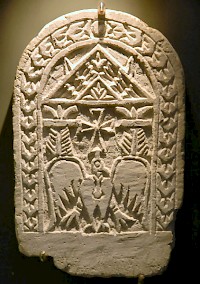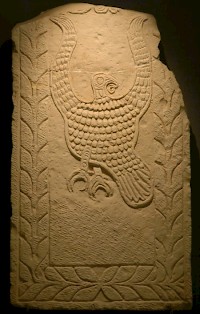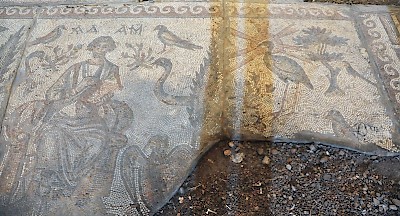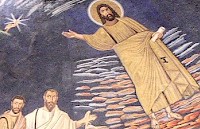Phoenix
Phoenix: mythological bird from Egypt. The Egyptian mythology and its Greek interpretations must be distinguished.

In Egyptian mythology, the bird benu (or purple heron) played an important role. During the flood of the Nile, this beautiful, bluish bird rests on high places and resembles the sun floating over the waters. Therefore this bird, sometimes called "the ascending one", was associated with the sun god Ra, whose ba (soul) it was thought to be. The benu was especially venerated in the town that is usually called Heliopolis ("city of the Sun").
According to the Heliopolitan myth, the benu had created itself from a fire that was burned on the holy jšd-tree in one of the sacred precincts of the temple of Ra. It had rested on a pillar that was known as the bnbn-stone. The priests showed this pillar to visitors, who considered this the most holy place on earth. In another myth, the famous bird was associated with the god Osiris, who had once renewed itself. The benu had sprung from the god's heart.
Because the bird was thus associated with creation and renewal, it was easily connected with the calendar. Indeed, the temple of the benu was well-known for its time-keeping devices (clepsydrae) and the priest who was responsible for the calendar.
The first Greek known to have mentioned the phoenix ("the 'brilliant one"), was the poet Hesiod (c.700 BCE), who in The precepts of Chiron stresses the phoenix's longevity of almost 100,000 years.
A chattering crow lives out nine generations of aged men,
but a stag's life is four time a crow's,
and a raven's life makes three stags old,
while the phoenix outlives nine ravens,
but we, the rich-haired Nymphs
daughters of Zeus the aegis-holder,
outlive ten phoenixes.

The next step in the development of the myth can be found in the Histories of the Greek researcher Herodotus of Halicarnassus, who again stresses the element of longevity. His story is probably based on a description by Hecataeus of Miletus.
There is also another sacred bird called the phoenix, which I did not myself see except in painting, for in truth he comes to the Egyptians very rarely, at intervals, as the people of Heliopolis say, of five hundred years. They say that he comes regularly when his father dies; and if he be like the painting, he is of this size and nature, that is to say, some of his feathers are of gold color and others red, and in outline and size he is as nearly as possible like an eagle. This bird, they say (but I cannot believe the story), contrives as follows.
Setting forth from Arabia he conveys his father, they say, to the temple of the Sun plastered up in myrrh, and buries him in the temple of the Sun. He conveys him thus. He forms first an egg of myrrh as large as he is able to carry, and then he makes trial of carrying it, and when he has made trial sufficiently, then he hollows out the egg and places his father within it and plasters over with other myrrh that part of the egg where he hollowed it out to put his father in, and when his father is laid in it, it proves (they say) to be of the same weight as it was; and after he has plastered it up, he conveys the whole to Egypt to the temple of the Sun. Thus they say that this bird does.note

Later sources tell us that the phoenix burned itself, and was born again from the flames. This is the Greek myth that became most popular in our own time; we can still say that something rises "like a phoenix from the flames". The animal was well-known to other people. For example, the Jewish author of 3 Baruch refers to the bird, and the Jewish playwright Ezekiel (second century BCE) mentions the phoenix in his play about Moses.
Another living creature we saw,
full wondrous, such as man has never seen;
'twas near in scope to twice the eagle's size,
with plumage iridescent, rainbow-hued.
Its breast appeared deep-dyed with purple's shade,
its legs were red like ochre, and its neck
was furnished round with tresses saffron-hued;
like a coxcomb did its crest appear,
with amber-tinted eye it gazed about,
the pupil like some pomegranate seed.
Exceeding all, its voice pre-eminent;
of every wing'd thing, the king,
it did appear. For all the birds, as one,
in fear did haste to follow after him,
and he before, like some triumphant bull
went striding forth with rapid step apace.note

The Roman author Tacitus mentions an appearance of the phoenix in 34 CE.note During the reign of Claudius, a phoenix was brought to Rome, but the Roman author Pliny the Elder says that it was probably not a real phoenix.note Quoting Lucius Manilius, Pliny says that the bird dies on a nest of cinnamon and similar herbs, and that a new phoenix is born from the bones of the dead bird.

One generation later, the poet Martial used the phoenix as symbol of Rome's eternity.note After this, it was easy for the first Christians to make the beautiful bird the symbol of the resurrection,note and the authors of Late Antiquity continued to write about this animal.note
In his Life of Apollonius, the Greek author Philostratus refers to the phoenix as a bird living in India, but sometimes migrating to Egypt.note His account is clearly inspired by Garuda, the bird of the Indian god Vishnu. His contemporary Lactantius is probably the author who wrote the longest poem on the famous bird (go here).